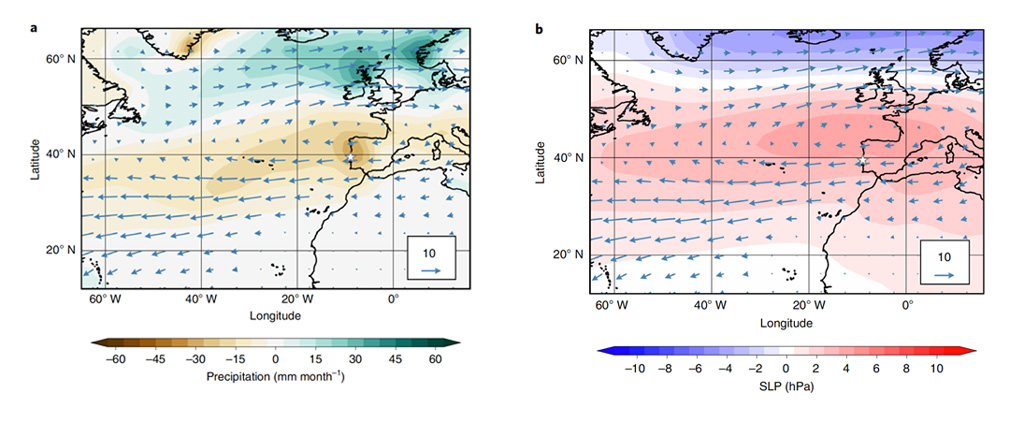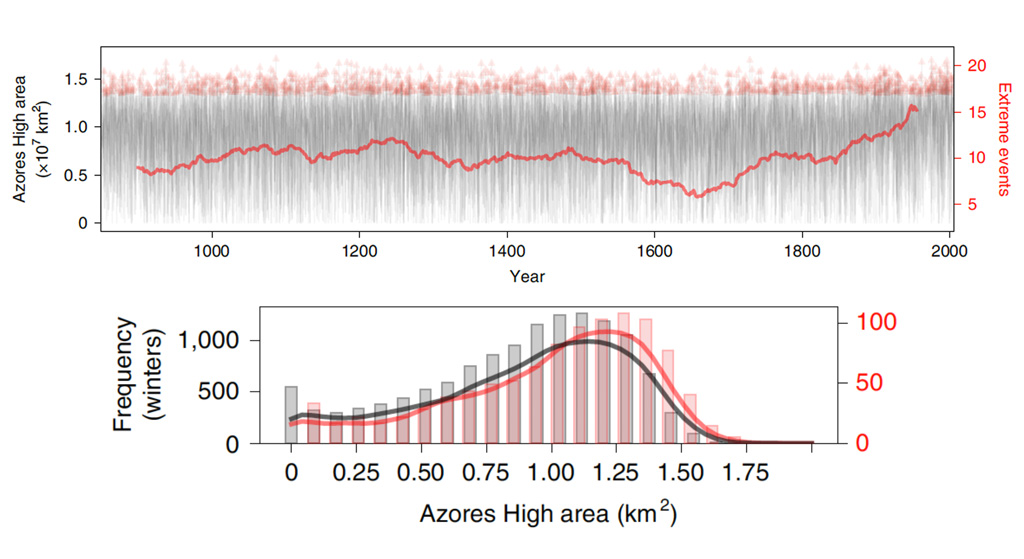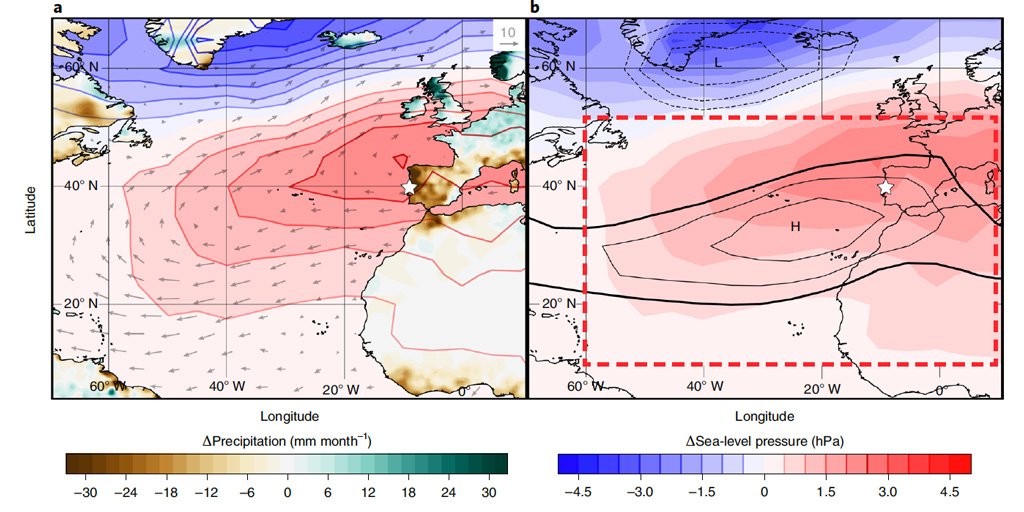Development of the “Azores extreme” – a extreme pressure system throughout the north Atlantic – is driving “unprecedented” changes in western Europe’s native climate, new evaluation suggests.
The analysis, revealed in Nature Geoscience, pulls collectively observations, model simulations and palaeoclimate information to analyse changes throughout the north Atlantic native climate over the earlier 1,200 years. The authors uncover that the Azores extreme – which they identify a “gatekeeper” for European rainfall – has expanded as a result of the planet has warmed.
Winters with an “terribly huge” Azores extreme are linked to drier winter circumstances all through the Mediterranean and wetter local weather throughout the UK. These extremes have develop into further frequent given that industrial revolution – rising from one extreme winter every 10 years throughout the pre-industrial interval to at the very least one every 4 years throughout the twenty first century, the analysis finds.
As a result of the Azores Extreme continues to develop, drying will intensify in Spain and Portugal. The world will see a 10-20% drop in winter rainfall over the approaching century – making agriculture of the realm “among the many most inclined in Europe” – the authors warn.
The analysis describes the expansion of the Azores extreme “unprecedented before now 1,200 years”. Nonetheless, a scientist not involved throughout the evaluation tells Carbon Short-term that not all the native climate fashions used throughout the analysis help this conclusion.
‘Gatekeeper of precipitation’
Europe encompasses a wide range of climates. A number of the continent – along with the UK and much of mainland Europe – is characterised by affordable temperatures and moist circumstances all 12 months spherical. Within the meantime, southern Europe has a Mediterranean native climate of scorching, dry summers and funky, moist winters.
Nonetheless, in present a few years, these climates have seen a shift. Winter rainfall over the western Mediterranean has decreased in present a few years by 5-10 mm per 12 months, the analysis says. By 2100, a further 10–20% drop in winter rainfall is anticipated – with excessive implications for agriculture in worldwide areas along with Spain and Portugal. Within the meantime, the UK is seeing wetter winters.
To find the reason for the present changes in western European rainfall, the authors of the analysis consider the Azores extreme – an area of extreme pressure throughout the North Atlantic named after the Azores archipelago west of Portugal.
Customary by dry air descending throughout the subtropics, the Azores extreme causes winds to flow into clockwise spherical northern Africa, the jap coast of the US and western Europe. Westerly winds travelling all through the North Atlantic resolve up moisture, and draw it over Europe, the place it falls as rain.
The size and depth of the Azores extreme shifts 12 months on 12 months, driving variations in rainfall ranges over the continent. As such, the analysis refers again to the system as a “gatekeeper of precipitation” over Europe.
Dr Caroline Ummenhofer – a bodily oceanographer on the Woods Hole Oceanographic Institution throughout the US – is an creator on the analysis. She tells Carbon Short-term that the Azores extreme is “a extraordinarily important native climate attribute throughout the North Atlantic”, together with {that a} massive Azores extreme “pushes wind and rain bearing local weather methods extra north”, inflicting drying over Spain and Portugal and wetter circumstances over the UK.
To seek out out historic changes throughout the Azores extreme, the authors consider sea diploma pressure – the air pressure at sea diploma – all through the North Atlantic in a given winter to the long-term widespread. If sea diploma pressure is above a positive threshold, the authors define the Azores extreme event as “extreme”.
To show how the Azores extreme can impression north Atlantic native climate, the authors simulate rainfall and sea diploma pressure in a winter with an “extreme” Azores extreme using a gaggle of fashions known as the “last millennium ensemble”.
The plots beneath current rainfall (left) and sea diploma pressure (correct) all through a winter with an “terribly huge” Azores extreme. The inexperienced shading displays higher rainfall over the UK, whereas the brown shading displays lower rainfall over Portugal and Spain. The purple and blue shading current extreme and low sea diploma pressure, respectively, and the arrows current the course of moisture transport.

The authors uncover that an “extreme” Azores extreme event brings spherical 35.3 mm per thirty days a lot much less rainfall to the western coast of the Iberian Peninsula – a reduction of spherical one third.
‘Unprecedented progress’
The authors look at how the Azores extreme has modified over the earlier millennium by combining three strains of proof. They use native climate fashions to simulate changes in climate situations given that 12 months 850, and observations of sea diploma pressure and rainfall to search out out the native climate in present a few years.
To verify rainfall ranges a millennium prior to now – sooner than observed information was collected – the authors flip to palaeoclimate information taken from stalagmites in Buraca Gloriosa collapse Portugal. Stalagmites are formed over prolonged intervals of time from the assemble up of mineral deposits – primarily calcium carbonate – carried by groundwater percolating via the rock.

Ummenhofer tells Carbon Short-term that stalagmite carbonate chemistry varies counting on environmental circumstances, so scientists can check out the carbon isotope doc alongside the dimensions of the stalagmite to search out out historic rainfall ranges. She offers that “fortunately”, the Buraca Gloriosa cave is “located correct throughout the bullseye of the place the Azores extreme drying is expert”.
The authors uncover that the three strains of proof agree correctly with one another on earlier changes throughout the north Atlantic.
The plots beneath current changes throughout the frequency (excessive) and area (bottom) of the Azores extreme over the earlier millennium. Inside the excessive plot, the purple line displays the number of winters with an extreme Azores extreme, measured over a 100-year window. Explicit individual model runs are confirmed in grey, and explicit individual extreme events are confirmed with triangles. Inside the bottom plot, the grey bars current the size of the Azores extreme throughout the pre-industrial (grey) and industrial (purple) eras. The larger the bars to the suitable of the plot signifies a greater frequency of Azores extreme methods with a giant area.

The authors uncover that the size and the number of “extreme” winter Azores highs has “elevated significantly”, from one every 10 years throughout the pre-industrial interval to at the very least one every 4 years throughout the twenty first century.
The title of the analysis describes this progress of the Azores extreme “unprecedented before now 1,200 years”. Nonetheless, Dr Jacob Scheff – an assistant professor on the Faculty of North Carolina, Charlotte, who was not involved throughout the analysis – questions this assertion:
“Whereas this analysis is of considerable curiosity, it does not really current that the real-world Azores extreme progress is unprecedented throughout the last 1,200 years. As an alternative, it displays that in a single specific native climate model, the expansion is unprecedented throughout the last 1,200 years in most simulations.”
As not all fashions used throughout the analysis help this conclusion, Scheff warns that “the title assertion is simply not justified by the analysis”.
The authors moreover uncover changes throughout the Azores extreme since 1950 by using observations of sea diploma pressure and rainfall to verify its widespread dimension in 1950-79 and 1980-2007. That’s confirmed throughout the maps beneath.
Brown shading signifies a decrease in rainfall over time, whereas inexperienced signifies an increase. Blue and purple symbolize lowering and rising sea diploma pressure, respectively. The dashed discipline displays the world thought-about on this analysis. The star displays the positioning of the Buraca Gloriosa cave. “H” and “L” correspond to 2 pressure methods over the Atlantic Ocean – the Azores extreme and “Icelandic low” – an area of low pressure located between Iceland and southern Greenland.

Winter rainfall over western Mediterranean has decreased in present a few years by 5-10mm per 12 months, the plot displays. Within the meantime, the UK has seen a sample of accelerating rainfall.
Attribution of the Azores extreme progress
Lastly, the authors look at what introduced on the Azores extreme to develop. They use native climate fashions to simulate what variety of extreme Azores extreme events would have occurred over the earlier 1,200 years beneath a wide range of varied native climate circumstances.
The plot beneath displays the completely completely different drivers examined. The inexperienced line displays model runs that solely take into consideration changes in greenhouse gasoline emissions, purple displays solely changes in volcanic train, yellow displays solely changes in picture voltaic train and black displays all three.

The plot displays {that a} rise in extreme Azores extreme events over the earlier 100 years is most interesting captured by the model when greenhouse gasoline emissions are included.
Dr Justin Mankin – an assistant professor throughout the division of Geography on the Faculty of Dartmouth, who was not involved throughout the analysis – tells Carbon Short-term that “the paper is fascinating and the authors clearly did a lot of good analysis on the footprint of the Azores extreme”.
Nonetheless, he offers that changes throughout the dimension and depth of the Azores extreme could even have been pushed by changes in aerosol ranges, pretty than changes in greenhouse gases emissions. (As an illustration, the passing of the US Clear Air Act throughout the Seventies observed air air pollution ranges drop significantly, inflicting localised warming.) That the authors did not look at this challenge is “a curious omission” he says.
The analysis signifies that the Azores extreme progress is linked to changes throughout the Hadley circulation – a critical atmospheric circulation system which cycles air between the equator and the mid-latitudes. The video beneath explains the Hadley circulation, and the alternative “cells” throughout the Earth’s ambiance that switch heat from the equator to the poles.
As a result of the native climate warms, the Walker and Hadley circulations are weakening and widening, decreasing the mixing of air all through completely completely different altitudes and drying the ambiance. Evaluation revealed last week linked the weakening of these circulations to a reduction throughout the number of tropical cyclones worldwide.
Ummenhofer tells Carbon Short-term that “changes within the route of additional frequent huge wintertime Azores extreme situations are per a widening of the Hadley Circulation in a warming native climate”.
Prof Richard Seagar – a evaluation professor at Columbia Faculty, who was moreover not involved throughout the analysis, tells Carbon Short-term that the expansion throughout the Azores extreme may also “merely be outlined by the long-term variability and changes of the North Atlantic Oscillation”.
The North Atlantic Oscillation (NAO) is probably going one of the crucial important drivers of pure variability throughout the Atlantic, and is pushed by the pressure distinction between the Azores extreme and Icelandic low. The video beneath explains how the NAO influences local weather throughout the UK.
Seagar tells Carbon Short-term that it “could be good if [the authors of the study] confirmed the timeseries of the Azores extreme dimension with that of the NAO”, so that changes throughout the two over time may be in distinction. He offers that he is “undecided how novel” the findings are.
Within the meantime, Mankin offers that he “struggled with a couple of analytical selections”. He says:
“I really feel the vital factor questions that come up for me is whether or not or not they’ve truly sampled variability throughout the Azores extreme, and whether or not or not they’ve attributed its changes. I really feel they’ve started that work, nonetheless I’m not utterly happy they’ve accomplished each to the extent that we may very well be assured throughout the attribution of the particular world.”
Cresswell-Clay et al (2022), Twentieth-century Azores extreme progress unprecedented before now 1,200 years, Nature Geoscience, doi:10.1038/s41561-022-00971-w
Sharelines from this story
